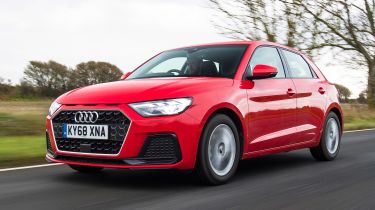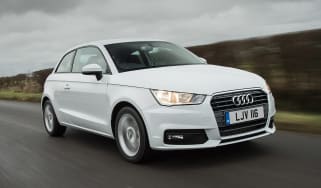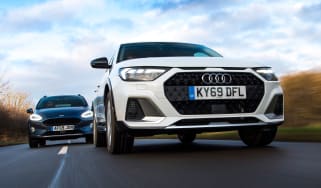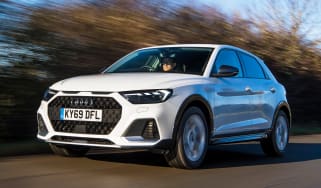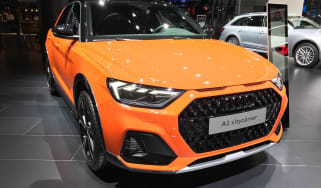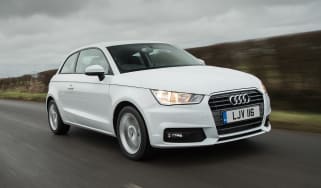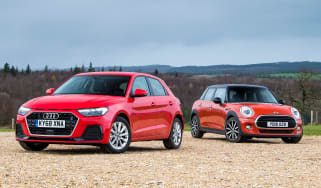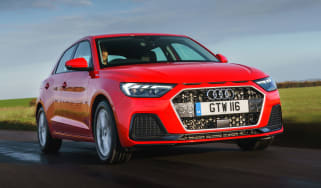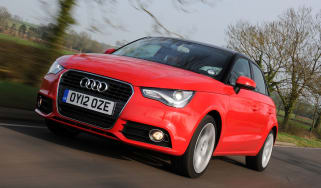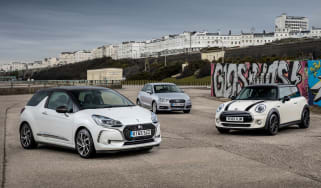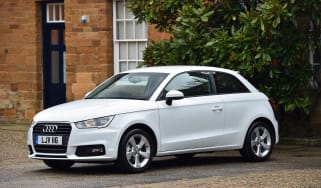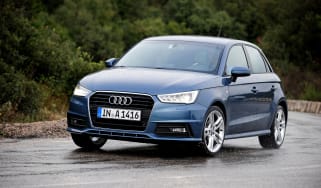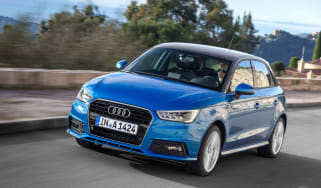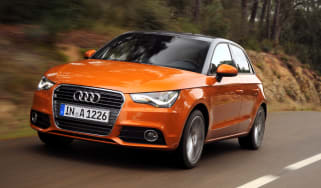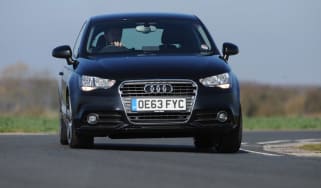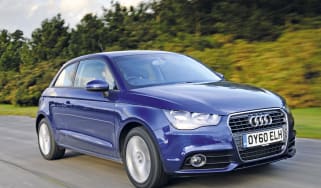Audi A1 review: premium small hatch still impresses
The Audi A1 is a luxurious and sporty-looking small hatch that gives the MINI a run for its money

The Audi A1 still maintains a strong, stylish appearance, and with its wide grille similar to that of the Audi R8 supercar, the luxurious supermini looks distinctly sporty. The reality is less exciting on the road, because although the A1 handles very competently and rides well, it doesn’t have the sporty responses of its key rival the MINI. It wins back ground when it comes to refinement though, as the A1 is almost as hushed and relaxed to ride in as a Mercedes C-Class.
The interior design looks very upmarket-Audi too, but closer inspection reveals very similar materials used to the much cheaper VW Polo. Engine choice is limited, but performance is satisfactory, and with only a roomy five-door body available it’s practical too.
About the Audi A1
The second-generation Audi A1 is now only available as a five-door hatchback, which Audi refers to as a Sportback, while the higher-riding Citycarver model with its SUV-lite styling was discontinued back in 2021. Powertrain and trim options have been pared back over time, too, as Audi shifts its focus to production of larger, more premium models.
The A1 line-up now begins with the Sport specification, followed by S line and Black Edition versions, with the previous entry-level Technik and the top-of-the-range Vorsprung trim no longer available.
Sport variants give you 16-inch 10-spoke turbine style alloys, matt black exterior accents, rear parking sensors, front sport seats and cruise control, while S line upgrades to 17-inch 5-spoke alloys, lowered firmer suspension and an exterior styling pack. The Black Edition adds 18-inch alloys and black exterior trim including a contrast roof.
Engine options for the A1 include a 1.0-litre, three-cylinder unit with 94bhp, badged 25 TFSI and available with either five-speed manual, or seven-speed S tronic auto transmission. Then there's the 108bhp 30 TFSI, offered with either a six-speed manual or seven-speed S tronic auto. The 35 TFSI introduces a 1.5-litre four-cylinder engine with 148bhp mated to the seven-speed auto transmission. The old S Line Competition version with a 204bhp 2.0-litre unit, badged 40 TFSI is not longer offered.
Given its high pricing, the Audi A1 has always been attempting to carve out a niche as ‘the’ premium supermini, it seems. It has the less practical MINI line-up to contend with of course, but its biggest problem may be the sheer quality and desirability of its Volkswagen Group stablemate the Volkswagen Polo, which offers similar tech and build quality, for a lot less cash. Other possible rivals in the style-led small car market include the Peugeot 208 and the Fiat 500, but neither feels as grown-up or premium as the Audi A1.
Engines, performance and drive
The Audi A1 is very well resolved car to drive, and it copes well with the rigours of the UK’s desperately tired and potholed tarmac. At least, that's true of the smaller-wheeled versions, which ride with a pleasing degree of compliance. We’d recommend test driving the 18-inch options before you buy because they add a degree of jiggle.
Some customers are likely to find the additional harshness they introduce to proceedings disappointing, although others will consider it a worthwhile trade-off for the extra style of the bigger wheels. The sports suspension set-up of the S Line cars is harsher too, to the extent that passengers may find longer journeys a bit of a chore.
Steering is accurate and well weighted, and in standard guise the A1 resists excessive body roll effectively, although it isn’t as responsive as a MINI which is more entertaining for the engaged driver. The A1 wins out for refinement though, as it feels as hushed as a premium saloon car two classes up.
The seven-speed S tronic dual-clutch auto works very smoothly, and is likely to appeal more to most customers than the manual which is ever so slightly notchy in operation.
0-62mph acceleration and top speed
With 108bhp under the bonnet, the 1.0-litre 30 TFSI models can do 0-62mph in 9.4 seconds when coupled with the S tronic transmission – although high gearing means it doesn’t feel quite as fast as it might from the driver’s seat. Top speed is 126mph.
The 25 TFSI has 94bhp and is slightly more laboured, making its way from 0-62mph in 10.8 seconds. With 148bhp and 250Nm of torque, the 1.5-litre 35 TFSI is able to produce a more athletic performance, achieving a 0-62mph time of 7.7 seconds and a top speed of 137mph.
MPG, CO2 and running costs
The 25 TFSI is the smallest-engined A1 you can buy, so it's not surprising it's also pleasingly economical. The three-pot 1.0-litre can return up to 50.4mpg on the WLTP combined cycle and emits 127g/km of CO2 in Sport form. There are no hybrid or ‘green’ powertrain options, but efficiency of the base model remains impressive.
The 35 TFSI has cylinder deactivation to improve its figures. By cutting off fuel to half the cylinders when they’re not under load, you can mimic the efficiency of a smaller engine. Despite having 148bhp and a 0-62mph time of 7.7 seconds, the 35 TFSI can return up to 48.7mpg with CO2 emissions from 132g/km.
In the mid-range is the 30 TFSI, which is in its most efficient guise when mated with the six-speed manual 'box - managing 52.3mpg and emitting 123g/km of CO2.
In general terms, the Audi A1 shouldn’t cost any more to run than similarly high-spec supermini rivals, at least when it comes to filling up, insurance and road tax. However, maintenance costs could be a little higher than some, as you’ll be helping to play for all those swishy Audi showrooms.
Insurance groups
The 25 TFSI is the cheapest to insure as that’s only in Group 16. When the sportier models arrive the bills go up according to performance, with the most expensive models to insure being the 35 TFSI, which is Group 25 and the discontinued 40 TFSI, which is Group 31.
Depreciation
Residual values for the A1 remain strong, with the five-door hatch retaining an average of 56 per cent of its value over three-years and 36,000 miles. The 108bhp 1.0 TFSI model in Sport or S line trim holds onto nearer 60 per cent of its original list price after 36 months of ownership.
To get an accurate valuation on a specific model check out our free car valuation tool...
Interior, design and technology
The latest Audi A1’s design is not particularly radical by the standards of other manufacturers, but its style is pretty funky compared to the German marque’s usual fare. The old model was definitely looking a little dated, but this one is arguably one of the sportiest looking models in the Audi line-up.
That’s obviously the look the marque was going for, as the large trapezoidal front grille with matching black air intakes either side, and those three slots under the leading edge of the bonnet, are all style cues lifted directly from the Audi R8 supercar.
You need to be a bit more of an Audi-phile to pick up on some of the other design cues. For example the lines pressed into the bonnet and shoulders above the wheelarches are both supposed to evoke images of classic Audi Quattro rally cars. Contrasting paint on the roof and screen pillars of certain models adds to the visual interest too.
The Audi A1 is built at SEAT’s plant in Martorell, Spain, and shares its MBQ platform with the VW Polo and SEAT’s Ibiza Mk 5. But aside from the common engineering, there’s not a lot to place the stablemates in the same family, either outside or in the A1’s impressive cabin.
The digital dashboard design is visually highly appealing, and very high-tech, with Audi’s ‘Virtual Cockpit’ display optional for all model variants. It sits in a wrap-around binnacle with everything slanted towards the driver, and there are shades of the A8 limousine’s cabin style, although you don’t get the twin central touchscreens of Audi’s more luxurious models and have to use ordinary buttons for controlling the climate control.
Sat-nav, stereo and infotainment
The Audi A1 comes with an 8.8-inch infotainment screen, and an audio system with DAB and Audi’s Smartphone system which includes Apple CarPlay and Android Auto. All cars feature Audi's 10.25-inch Digital Cockpit driver's display while the full (and very impressive) Virtual Cockpit is part of the optional Technology Pack Pro along with the bigger 10.1-inch infotainment touchscreen display.
Practicality, comfort and boot space
The three-door A1 variant is long gone and because the new generation is bigger than before, owners of the previous generation car will find the latest five-door Audi supermini is a lot more useful.
Five-doors means easy access to the rear for baby seats and the like, and the extra space inside means more adjustment for the driver’s seat so it will be easier for all shapes and sizes to get comfy. Forward visibility is fine too, although rear parking sensors will be a boon for some when reversing, as like many modern hatchbacks the rear view is hardly panoramic. Should you choose to seek out a used example of the discontinued Citycarver model, you'll benefit from a 50mm extra ride height and a softer, more comfortable drive.
In other respects, the cabin is typical Audi, with a decent glovebox, door pockets and storage in the centre console, plus cup-holders between the seats. Practicality is also enhanced by the application of so much tech. The optional Virtual Cockpit dash in particular offering up navigation info that’s easily assimilated by the driver.
Dimensions and size
Although its sporty style is eye-catching, the Audi A1 is basically fairly boxy when you look beyond the decorative elements of the design. It’s also bigger than before, and so compares favourably to rivals for interior and boot space. It measures up at 4,029mm long and 1,940mm wide, which is, however, a little shorter than the VW Polo’s 4,053mm length. The A1 Citycarver adds 15mm to the overall length and is also 76mm taller.
Leg room, head room & passenger space
There’s plenty of room in the front seats, while two rear seats passengers are accommodated comfortably, without squashed knees or cricked necks. A third rear passenger will be a squeeze, but the same goes for all cars in the Audi A1’s supermini class.
Boot space
Compared to the old A1, there’s been a big boost in luggage capacity – up 65 litres to 335 litres in total. If you fold the rear seats, which don’t quite go flat, but are split 60:40, then total luggage space goes up to 1,090 litres.
Reliability and safety
The Audi A1 received a full-five-star rating when tested by Euro NCAP in 2019. It shares its platform with the VW Polo which scores highly in the Euro NCAP tests, and it’s also well equipped with features such as emergency braking and lane-keeping assistance. That said, you don’t get blind-spot monitoring or traffic sign recognition on the A1, which are two technologies that are finding their way down into the small car sector elsewhere.
The VW Group platform and technology sharing should also reassure buyers when it comes to reliability, with an engine line-up shared across the Polo and SEAT Ibiza ranges. Some of the more advanced stuff like the Virtual Cockpit display is perhaps less of a known quantity, but it has appeared widely higher up the Audi line-up.
Build quality appears impeccable too, notwithstanding the fact that some of the interior materials could feel a bit richer. It’s all screwed together impeccably, and the construction seems rock solid.
The A1 didn't feature in the top 75 cars in our 2023 Driver Power customer satisfaction survey, while Audi placed a very disappointing 30th out of 32 manufacturers in the best brands poll.
Warranty
The Audi A1 comes with the standard manufacturer warranty, which means you get three years and 60,000 miles of cover – the same as for a VW Polo. There are extended warranty options available at extra cost, but it’s not a particularly impressive offer. The MINI line-up comes with three years cover, but the advantage of unlimited mileage.
Servicing
If you do a relatively low mileage, Audi recommends you use their annual service regime. If you’re going to drive over 10,000 miles a year, then there’s a ‘long life’ service schedule based on monitoring oil quality and sensors to tell you when a service is required. Audi also offers fixed price plans to help you budget for maintenance.
Used and nearly new Audi A1
Audi launched the second-generation A1 in 2018, so you shouldn't have too much trouble in sourcing a decent used example. Although it's the smallest model in the German manufacturer's lineup, the A1 still benefits from the brand's smart, sophisticated image, which means second-hand prices remain pretty buoyant. You'll certainly pay more for an A1 compared to most of its rivals, but you should get a decent chunk of that back if you choose to eventually sell the car on.
Audi A1 Mk1: 2010-2018
The Audi A1 was launched in the UK in 2010 as a three-door hatchback model, with the five-door Sportback version following a year later. As a premium small car the A1 was pitched to compete with the classy MINI hatch, offering sharp styling, a first-rate interior and build quality to rival more expensive machinery.
Under the skin, though, the A1 used the same basic architecture as its VW Polo, Skoda Fabia and SEAT Ibiza cousins, which meant it didn't really offer up as much driving fun as the MINI. That wasn't really the point of the A1, however, and its small car luxury feel helped to win over buyers.
Audi offered a range of trim levels for the 1st-gen A1, so you should have plenty of choice when it comes to deciding which model to go for: entry SE still offers a good level of kit, although mid-range Sport and the popular S line specification include appealing features such as sports seats, bigger wheels and improved on-board tech. Read our full Audi A1 Mk1 buyer’s guide here…
More reviews
Which Is Best
Cheapest
- Name25 TFSI Sport 5dr
- Gearbox typeManual
- RRP£23,810
Most Economical
- Name25 TFSI Sport 5dr
- Gearbox typeManual
- RRP£23,810
Fastest
- Name35 TFSI S Line 5dr S Tronic
- Gearbox typeSemi-auto
- RRP£28,560

